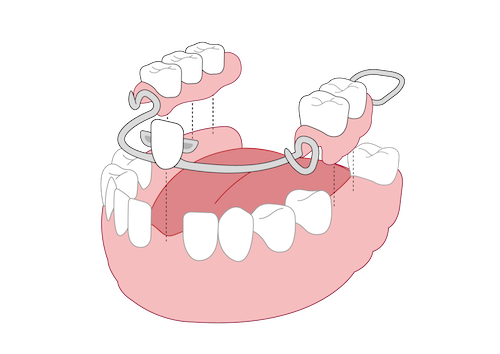6
Keep smiling with a removable partial denture
A removable partial denture (RPD) is a plastic or metal frame with false teeth attached to it. The denture fits closely against the gums with clasps wrapped around your natural teeth to secure it in place.
Image
 |
When/why should you choose this option?
- RPDs are good at replacing multiple teeth and are an effective solution if you have lost the bone that once supported the teeth.
- They can be used for front and back teeth, the lower and upper parts of your mouth, and can readily replace teeth in a ‘free end saddle situation’. This is when you have no teeth at one or both ends.
- They are simple to manufacture and use, and they are a relatively low-cost treatment option.
- Depending on the material used and other factors, RPDs may be modified if further teeth are lost.
What do you need to be aware of?
- It is removable and moveable. Its stability will depend on the support or retention available from the remaining teeth in the mouth.
- It can take time to get used to wearing one
- RPDs can increase the build-up of plaque around the teeth that help to support it. This increases their risk of caries and gum disease, which could lead to further tooth loss. Good oral hygiene is essential to help manage and prevent this.
- Further tooth loss may impact how the partial denture functions and how comfortable it feels.
- Over time, there is also the risk of a false tooth weakening, causing it to break off from the denture.
What will you need to do to improve your chance of long-term success?
- Brush your teeth twice a day with a toothpaste containing at least 1,100 ppm fluoride if your risk of dental caries is low. If the risk of caries is high, your dentist may recommend a toothpaste with higher fluoride content and further fluoride treatments.
- Use dental floss and/or interdental brushes to clean between your teeth. This is especially important around your abutment teeth.
- Remove your denture(s) and clean them thoroughly with a soft toothbrush after each meal.
- It is advisable to soak your dentures overnight in a suitable denture cleanser. Avoid hypochlorite cleansers for metal-based dentures.
- Eat a well-balanced diet that is low in sugar.
- Your dentist will assess your risk and need for periodic review. This might be between 3-6 months depending on his/her recommendation.
What if there are problems?
- If there is further tooth loss, your dentist may be able to modify your existing partial denture. If that is not possible, a new one may need to be made.
What other factors do we need to consider?
- Invasiveness of procedure: RPDs are less invasive than other tooth replacement options.
- Treatment fees: It is one of the more affordable options when it comes to replacing a missing tooth/teeth.
How does this option affect you?
The fit of a partial denture is very important in order to look and function as normal as possible. It can help to improve problems related to smiling and eating. For some, however, it may feel the least comfortable compared to other treatment options.